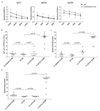A Restricted Role for FcγR in the Regulation of Adaptive Immunity
- PMID: 29523656
- PMCID: PMC5896742
- DOI: 10.4049/jimmunol.1700429
A Restricted Role for FcγR in the Regulation of Adaptive Immunity
Abstract
By their interaction with IgG immune complexes, FcγR and complement link innate and adaptive immunity, showing functional redundancy. In complement-deficient mice, IgG downstream effector functions are often impaired, as well as adaptive immunity. Based on a variety of model systems using FcγR-knockout mice, it has been concluded that FcγRs are also key regulators of innate and adaptive immunity; however, several of the model systems underpinning these conclusions suffer from flawed experimental design. To address this issue, we generated a novel mouse model deficient for all FcγRs (FcγRI/II/III/IV-/- mice). These mice displayed normal development and lymphoid and myeloid ontogeny. Although IgG effector pathways were impaired, adaptive immune responses to a variety of challenges, including bacterial infection and IgG immune complexes, were not. Like FcγRIIb-deficient mice, FcγRI/II/III/IV-/- mice developed higher Ab titers but no autoantibodies. These observations indicate a redundant role for activating FcγRs in the modulation of the adaptive immune response in vivo. We conclude that FcγRs are downstream IgG effector molecules with a restricted role in the ontogeny and maintenance of the immune system, as well as the regulation of adaptive immunity.
Copyright © 2018 by The American Association of Immunologists, Inc.
Figures








Similar articles
-
FcγRIIB (CD32B) antibodies enhance immune responses through activating FcγRs.Clin Exp Immunol. 2025 Jan 21;219(1):uxaf015. doi: 10.1093/cei/uxaf015. Clin Exp Immunol. 2025. PMID: 40089806 Free PMC article.
-
IgG is elevated in obese white adipose tissue but does not induce glucose intolerance via Fcγ-receptor or complement.Int J Obes (Lond). 2018 Feb;42(2):260-269. doi: 10.1038/ijo.2017.209. Epub 2017 Aug 30. Int J Obes (Lond). 2018. PMID: 28852207
-
Modulation of the immune response in pristane-induced lupus by expression of activation and inhibitory Fc receptors.Clin Exp Immunol. 2005 Aug;141(2):230-7. doi: 10.1111/j.1365-2249.2005.02847.x. Clin Exp Immunol. 2005. PMID: 15996187 Free PMC article.
-
The immunoglobulin, IgG Fc receptor and complement triangle in autoimmune diseases.Immunobiology. 2012 Nov;217(11):1067-79. doi: 10.1016/j.imbio.2012.07.015. Immunobiology. 2012. PMID: 22964232 Review.
-
FcγRIIB and autoimmunity.Immunol Rev. 2016 Jan;269(1):194-211. doi: 10.1111/imr.12368. Immunol Rev. 2016. PMID: 26683154 Review.
Cited by
-
Fcγ receptor-dependent antibody effector functions are required for vaccine protection against infection by antigenic variants of SARS-CoV-2.bioRxiv [Preprint]. 2022 Nov 28:2022.11.27.518117. doi: 10.1101/2022.11.27.518117. bioRxiv. 2022. Update in: Nat Microbiol. 2023 Apr;8(4):569-580. doi: 10.1038/s41564-023-01359-1. PMID: 36482975 Free PMC article. Updated. Preprint.
-
Involvement of Virus-Induced Interferon Production in IgG Autoantibody-Mediated Anemia.Int J Mol Sci. 2021 Aug 21;22(16):9027. doi: 10.3390/ijms22169027. Int J Mol Sci. 2021. PMID: 34445732 Free PMC article.
-
The Complex Association of FcγRIIb With Autoimmune Susceptibility.Front Immunol. 2019 Oct 15;10:2061. doi: 10.3389/fimmu.2019.02061. eCollection 2019. Front Immunol. 2019. PMID: 31681256 Free PMC article. Review.
-
Fc-γR-dependent antibody effector functions are required for vaccine-mediated protection against antigen-shifted variants of SARS-CoV-2.Nat Microbiol. 2023 Apr;8(4):569-580. doi: 10.1038/s41564-023-01359-1. Epub 2023 Apr 3. Nat Microbiol. 2023. PMID: 37012355 Free PMC article.
-
Antibody bivalency improves antiviral efficacy by inhibiting virion release independently of Fc gamma receptors.Cell Rep. 2022 Feb 1;38(5):110303. doi: 10.1016/j.celrep.2022.110303. Cell Rep. 2022. PMID: 35108544 Free PMC article.
References
-
- Takai T, Li M, Sylvestre D, Clynes R, Ravetch JV. FcR gamma chain deletion results in pleiotrophic effector cell defects. Cell. 1994;76:519–529. - PubMed
-
- Bruhns P, Jonsson F. Mouse and human FcR effector functions. Immunol Rev. 2015;268:25–51. - PubMed
-
- Fearon DT, Carroll MC. Regulation of B lymphocyte responses to foreign and self-antigens by the CD19/CD21 complex. Annu Rev Immunol. 2000;18:393–422. - PubMed
-
- Ahearn JM, Fischer MB, Croix D, Goerg S, Ma M, Xia J, Zhou X, Howard RG, Rothstein TL, Carroll MC. Disruption of the Cr2 locus results in a reduction in B-1a cells and in an impaired B cell response to T-dependent antigen. Immunity. 1996;4:251–262. - PubMed
Publication types
Grants and funding
LinkOut - more resources
Full Text Sources
Other Literature Sources
Molecular Biology Databases

